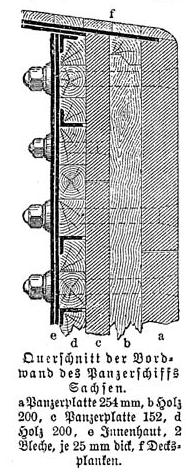SMS Saxony (1877)
|
|
|
|---|---|
|
|
|
| Construction data | |
| Shipyard | AG Vulcan in Szczecin |
| Keel laying | April 1875 |
| Launch | July 21, 1877 |
| completion | October 21, 1878 |
| Whereabouts | February 19, 1910 Retired May 5, 1919 Sold for scrapping |
| Technical specifications | |
| Displacement | 7,677 ts Maximum: 7,935 t |
| Length waterline length over all |
93 m 98.2 m |
| width | 18.3 m |
| Draft | 6.53 m |
| Armament | 6 × 26 cm L / 22 Rk From 1886: 5 torpedo tubes (2 × 45 cm in the sides, 2 × 35 cm in the bow and 1 × 35 cm in the stern) |
| Armor |
Citadel : 203-254 mm. Deck: 51-64 mm |
| Propulsion system | 8 suitcase boiler in boiler rooms 2 + 2 2 lying 3-cyl steam engines 2, four bladed screw 5 m |
| Machine performance | 5,000 PSi |
| Fuel supply | 420–700 tons of coal |
| speed | 13.5 kn |
| Driving range | 1,940 nm at 10 kn |
| crew | 317-436 men |
The tank corvette SMS Sachsen was the type ship of the Sachsen class named after it , a class of four warships of the Imperial Navy . The keel was laid in April 1875 at the AG Vulcan shipyard in Stettin . The launch took place on July 21, 1877, the commissioning on October 21, 1878.
The Saxony class
The first plans for the ships of the class were made as early as 1861. The four planned ships were primarily intended for coastal defense in the Baltic Sea area . Since the construction contract at the Szczecin shipyard was completed sooner than the first order at the Imperial Shipyard in Kiel , the Sachsen (household name: Panzerschiff B ) unexpectedly gave its class its name. Typschiff would otherwise have become her sister ship Bavaria ( Panzerschiff A ). From 1884 all four ships were operational. In the years 1896 to 1899 they were rebuilt and received new boiler systems with only one large chimney.
Technical specifications
The ship had a length of 97.8 m and a width of 18.3 m. The armament consisted of six 26 cm ring cannons with a 22 caliber length . Four of the six guns were positioned in the center of the ship and two in front open barbettes . From 1886 the ship also had 5 torpedo tubes (2 × 45 cm in the sides, 2 × 35 cm in the bow and 1 × 35 cm in the stern). The armor was made of wrought iron. The armor plates of the citadel were 203-254 mm thick. The deck had armor plates 51-64 mm thick. The crew numbered between 317 and 436 men. The drive consisted of two horizontally installed single expansion machines with eight suitcase boilers in two separate machine rooms. The chimneys were therefore arranged side by side in pairs; this led to the nickname "cement factory". The ships of this class were the first of the Imperial Navy to be built without auxiliary sails.
fate
On September 4, 1901, the Saxons collided with the Aviso Wacht off Rügen . She was placed on standby in 1902 and on second standby in 1906. From 1910 to 1918 the ship served as the target hulk of the fleet off the coast of Schwansen . The Sachsen was scrapped in Wilhelmshaven in 1919 .


